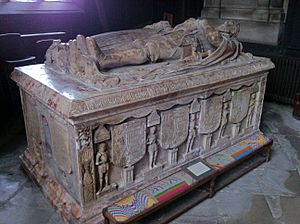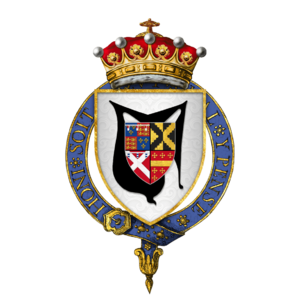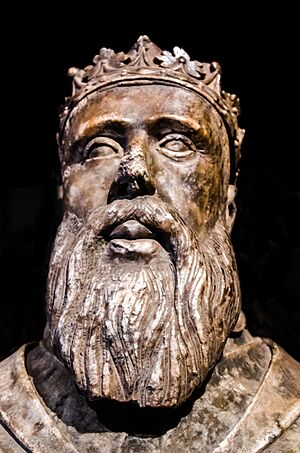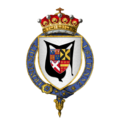Francis Hastings, 2nd Earl of Huntingdon facts for kids

Francis Hastings, 2nd Earl of Huntingdon, a Knight of the Garter, was an important English nobleman. He was born in 1514 and passed away on June 20, 1561. Francis was the oldest son of George Hastings, 1st Earl of Huntingdon and Anne Stafford, Countess of Huntingdon.
He grew up in Ashby-de-la-Zouch, a town in Leicestershire, England. When he was young, he was taught by John Leland, a famous historian. His father was given the title of the first Earl of Huntingdon by Henry VIII of England in 1529.
His Family and Children
Francis Hastings married Katherine Pole on June 25, 1532. Katherine was born in 1519 and died on September 23, 1576. Her father was Henry Pole, 1st Baron Montagu. Katherine's grandmother was Margaret Pole, 8th Countess of Salisbury, a very important lady who was related to the royal family.
Francis and Katherine had a large family with eleven children:
- Frances Anne Hastings (1533–1574). She married Henry Compton, 1st Baron Compton.
- Henry Hastings, 3rd Earl of Huntingdon (1536–1595). He became the next Earl.
- William Hastings (born 1537).
- George Hastings, 4th Earl of Huntingdon (1540–1604). He also became an Earl later.
- Sir Edward Hastings (1541–1603?). He married Barbara Devereux. Many future Earls of Huntingdon are related to Edward.
- Catherine Hastings (1542–1576). She married Henry Clinton, 2nd Earl of Lincoln.
- Walter Hastings (1544–1616). He married Joyce Roper.
- Elizabeth Hastings (c. 1546–1621). She married Edward Somerset, 4th Earl of Worcester.
- Anne Hastings (born 1548).
- Francis Hastings (c. 1550–1610). He married Maud Longford.
- Mary Hastings (born 1552). She was considered as a possible bride for Ivan the Terrible, the ruler of Russia, but the marriage did not happen.
Important Roles and Politics
Francis Hastings became a Knight of the Bath in 1533. This was a special honor given by the King. When his father passed away in 1544, Francis became the 2nd Earl of Huntingdon.
He played an important part in the coronation of Edward VI of England in 1547. He carried a special staff and took part in a jousting competition to celebrate.
Francis supported John Dudley, 1st Duke of Northumberland, a powerful leader at the time. He even helped to arrest Edward Seymour, 1st Duke of Somerset, another important figure, in 1549. For his loyalty, Francis was made a Knight of the Garter.
England was at war with Scotland and France. Francis was chosen to lead the army and navy in a campaign against Boulogne-sur-Mer, a French town. Even though he felt he didn't have enough money or supplies, the campaign ended with a peace treaty called the Peace of Boulogne. England gave up its claims in exchange for money.
After this success, Francis became a member of the Privy Council, a group of trusted advisors to the King. He traveled with King Edward VI and Northumberland, showing they trusted him. He also received several estates in Leicestershire.
In 1553, his oldest son, Henry, married Katherine Dudley. She was the daughter of Northumberland, which made their families even closer. Francis supported Lady Jane Grey as the next queen, but her reign was very short. When Mary I of England became queen, Francis was arrested and put in the Tower of London.
He was released in 1554 and was immediately asked to find and arrest Henry Grey, 1st Duke of Suffolk, Lady Jane Grey's father. Francis succeeded and brought Suffolk to the Tower. He was also present at the execution of Thomas Wyatt the younger.
Francis Hastings was related to Cardinal Reginald Pole, a close advisor to Queen Mary I. This connection helped Francis avoid trouble for being a Protestant during Mary's reign, as she was Catholic.
Francis Hastings died in 1561. He was buried in St Helen's Church, Ashby-de-la-Zouch, where you can still see his tomb today. His oldest son, Henry, became the 3rd Earl.
Images for kids
-
Alabaster tomb of Francis Hastings, 2nd Earl of Huntingdon in St Helen's Church, Ashby-de-la-Zouch






